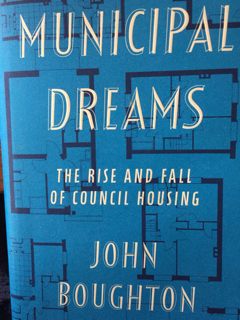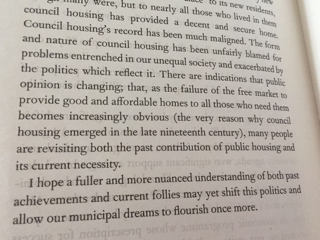John Boughton’s ‘Municipal Dreams’ website was a breath of fresh air when it first appeared four or five years ago. The Government had ended direct investment in new social rented homes, the housing sector had all but given up the struggle, and the council housing finance reforms, developed by John Healey when Labour was in power but implemented by the Tories in 2011, which had offered hope for a new generation of council homes, had been undermined to the point where they had become almost worthless.
It felt like a last act of defiance when the SHOUT campaign for social housing was launched in 2014 – although things were to get worse (the 2015 Housing and Planning Act) before they started to get better. And then Grenfell changed everything.
‘Municipal Dreams’ took a different approach from the economic and political arguments that SHOUT deployed. The website started with the aim of championing the pioneering achievements of local government but came to focus more specifically on council housing, looking at the social and architectural history of estates around the country. Although never pulling punches about the errors made, Boughton bred confidence amongst we readers that many of our council housing estates were good places to live, were well designed and well constructed, and could provide good homes for many years to come. It directly contradicted the characterisation by the media, some politicians, and even some people in housing, that council estates were all high rise concrete jungles, failed communities, brutal places that housed inadequate and workshy people that were ‘dependent’ on benefits. It became a must read.
Boughton’s book, also called ‘Municipal Dreams’ but subtitled ‘The Rise and Fall of Council Housing’, pulls together his remarkable knowledge of council estates all over the country – their planning, their development, their design, and their occupation – to illustrate the history of national council housing policy and finance and to comment on the successes and failures. The book starts where it ends, at Grenfell. Describing the devastating personal tragedy for those involved, Boughton also puts the disaster in its historical context: Grenfell, he says, is ‘an awful culmination to deeply damaging policies pursued towards council housing, and the public sector more widely, since 1979.’
Great value – you can buy Municipal Dreams here at half price if you move quickly!
The early chapters of the book describe the development of council housing and the ideals that drove those who planned, financed and built it to replace the old slums. He leads us into ‘the great programme of council house building which transformed our country, overwhelmingly for the better, up to the 1980s’. For those that like it, there is architectural detail which sometimes passes me by, but each example is always firmly linked to the policy and politics of the time. He dwells on the high point of Aneurin Bevan’s policy of building to high standards despite post-war austerity and the 1960s system-build revolution which provided so many homes but created as many problems, not because of the quality of the homes themselves but because of the quality of the build and structural flaws.
Later chapters, post 1979, become more political in nature, but that can be put at Thatcher’s door because she managed to politicise and polarise everything. He describes the long process of ‘residualisation’ of council housing – the narrowing of the social make-up of estates – and the emergence of so-called ‘problem estates’. I tend to disagree with his assessment of the impact of the 1977 Housing (Homeless Persons) Act. I don’t think the Act changed the social composition of council housing in the way that is often assumed – I think that is largely down to mass unemployment and the collapse in supply – although it did bring more people classified as ‘vulnerable’ (sometimes very young households or people with frail mental or physical health) into a sector which did not have the resources to ensure that these households were properly supported and integrated into communities.
Boughton’s assessment of the New Labour period is more of a lament. Council housing was hardly a New Labour thing. Very few new council homes were built, that job went to housing associations, but the Labour government did invest enormously and to its credit in bringing the long-neglected council housing stock up to a ‘decent’ standard, with millions benefitting from new kitchens and bathrooms and windows. But it was all done with an ideological edge that council housing should be distanced from the council either by transfer to a housing association or PFI body or by separation into an arms-length management organisation. His judgement, with which I agree, is therefore that ‘New Labour and its chosen agents improved both its fabric and management, but in a way which perpetuated the prejudices against it and undermined the values which sustained it.’
Ultimately, Boughton sees council estates as the victims of ‘our social and economic woes’ and not a cause. Those problems are disproportionately visited on the poorest people, and they are disproportionately – and quite rightly – housed on council estates. We should view council estates, he argues, ‘not as a problem but as a solution – offering secure and affordable housing – to the low pay and insecure employment which affects so many’.
Special attention is paid to the period after 2010, the huge rise in rents and therefore in housing benefit, abominations such as the bedroom tax and the welfare caps, and the removal of security of tenure in newly-let homes, culminating in the 2015 Housing and Planning Act which confirmed the government’s apparent intention to eliminate council housing. And he lambasts some of the many ‘regeneration’ (ie redevelopment) schemes being pursued on council estates, taking particular exception to the description of council estates as ‘brownfield sites’ and David Cameron’s rehash of every cliché and stereotype to justify his plans to redevelop 100 ‘sink estates’. Boughton believes some of these ‘regeneration’ schemes are ‘a desecration’.
The book identifies a little light at the end of a very dark tunnel: in the small new schemes of council housing around the country, and the significant shift in the politics of council housing brought about by the rise of Jeremy Corbyn and the horror of Grenfell. He ends with the hope that ‘a fuller and more nuanced understanding of both past achievements and current follies may yet shift this politics and allow our municipal dreams to flourish once more’.
Light at the end of the tunnel?
For anyone with an interest in (or even an obsession with) housing policy, the book is a great read. It has the detail which comes with real research but never loses sight of the long-term or the political framework. It is both about the extraordinary legacy of council housing and – if the politics can change – the enormous possibilities that exist in the future.


9 replies on “Let our Municipal Dreams flourish once more”
Although it was the 2015 Bill it is the Housing and planning Act 2016 Steve Tim
>
Thanks Tim, of course you are right. For those us who write too hastily without always verifying, it’s comforting to know we have such a great proofchecker in @4socialhousing!
Steve
I was just about to review Municipal Dreams for Chartist journal. Ca I use review on your blog instead. always useful for me to get a range of different reviewers rather than review everything myself.
Thanks
Duncan
Duncan – more than happy for you to do that. And if you get more publications across your desk than you can cope with, let me know!
Liked your piece on OnLondon – we do need a proper debate on the London Plan.
Regards
Steve
I hope that book starts with the Labour Party’s 1959 promise to sell our council houses to the tenants. That was the promise stolen by Thatcher in 1979.
I also hope this book tells all of us how to qualify for council housing and other social housing. After all, this is a mystery to most us.
It’s not a complete history or a housing manual so it doesn’t really do what you want except in general terms. There are government guides on allocations, every council must publish its allocation scheme, and there are tomes on the law governing allocations and homelessness. Hope you find what you want.
Winning public support for council housing
If only the needy are to be allocated council houses how do we terminate the tenancy of union bosses and others no longer in accord with these allocation criteria?
Having solved that problem how do we sell to the rest of us the prospect of a small lottery win going to those who rent a council house long enough to buy it from the council at a discount?
Reblogged this on Municipal Dreams and commented:
My first reblog and a little self-serving but I would also recommend Red Brick to anyone with an interest in contemporary housing policy. Apologies for the recent lack of original posting but normal service will be resumed shortly.
[…] Speakers include John Healey MP, Sarah Longlands from IPPR North, and social historian John Boughton, author of the brilliant history of council housing, ‘Municipal Dreams’ (see Red Brick review here). […]